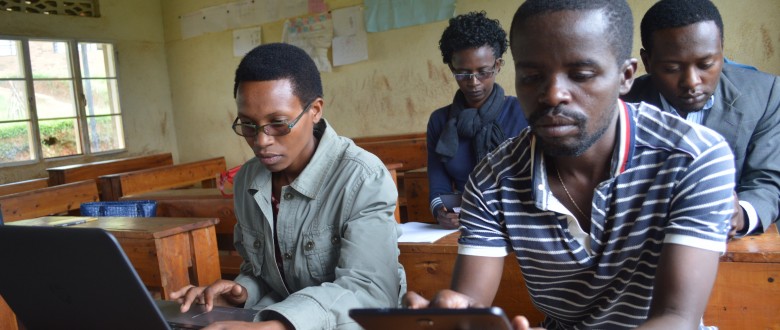
There is a lot to be said about infusing ICT into more traditional learning processes: more people can be reached; it fosters ownership; it reduces e.g. travel costs; etc. But making the change requires some well-thought out strategies to ensure all can benefit from it. VVOB shares its lessons from Rwanda, where its continuous professional development programmes have become ‘blended’.
ICT as a strategic lever
Technology-enhanced learning can increase the effectiveness and efficiency of continuous professional development (CPD) opportunities for teachers and school leaders. Especially true in contexts where individuals on the receiving end of CPD trajectories are geographically dispersed, it enables a learning experience that is flexible and personalised, and that fosters ownership.
Rwanda’s Vision 2020 puts ICT at the heart of its societal transformation, across all sectors. For education, ICT has been identified as one of the strategic levers for addressing the key challenges of access, quality, equity, relevance and management (ICT in Education Policy for Rwanda, 2016).
This is the framework within which VVOB has started integrating ICT in all its CPD training programmes in Rwanda, in the form of ‘blended learning’: learning that is made up of both traditional learning methods and ICT-based or distance learning activities.
Having initiated this move away from a traditional classroom-based CPD approach towards more ICT-enhanced CPD trajectories in 2017 already, VVOB is now ready to share some valuable experiences and lessons learnt.
Analysing with ADDIE
Before doing anything else, it is important to decide on an instructional design model to systematically structure the change process. For the transformation of the CPD courses in Rwanda, VVOB used the ADDIE model: analysis, design, development, implementation, evaluation.
In the initial phases of the change process, we conducted a needs-assessment study of the target audience and their environment. It taught us that trainees’ digital literacy skills were limited. Moreover, many beneficiaries could not rely on the necessary technologies to engage properly with the ICT-enhanced CPD courses in their work or home environments.
Equally early on, VVOB’s existing CPD content was also analysed to determine which aspects of the trajectories could be offered in blended modality. We landed on two units to start off with: Gender and Inclusion. Moreover, the CPD training programme Effective School Leadership for head teachers and deputy head teachers was identified to undergo the transformation to blended first, a verdict made based on (i) the programme’s competence-based and practical characteristics, (ii) the relatively long length of the programme, and (iii) the fact that the learning outcomes largely rely on active participation, input and discussion by trainees.
Today still, the Effective School Leadership programme has undergone the most far-reaching ICT transformation. Other CPD courses, e.g. on Mentoring and Coaching, have since followed suit.
Flipped classroom
Based on these initial analyses, VVOB found that ‘blended learning’ would be the most appropriate design to integrate ICT in the Effective School Leadership CPD training.
Taking a 100% digital route would put too much strain on the trainees considering the abovementioned challenges of digital literacy and connectivity, unnecessarily curbing learning outcomes. Blended learning, on the other hand, still allows for face-to-face workshop sessions in which trainees can be supported. In other words: the blended learning approach leaves room for trainees to learn content online from their own workplace or home, in their own time and at their own pace, while face-to-face sessions are dedicated to deepening understanding. A flipped classroom approach, if you will.
Looking at the perks for CPD facilitators, the blended learning design allows them to follow up closely on their learners’ progress individually, and to provide timely support where necessary.
Scaffolding for computer skills
To address the challenges of limited digital literacy and make sure trainees reap all the benefits from the blended learning approach, they were prepped beforehand with a Digital Literacy for Online Learning course developed by VVOB’s learning team. This course strengthens trainees’ ICT skills so they can properly participate in online learning environments (i.e. Moodle) and engage with online learning resources. VVOB also provided laptops and internet modems to 687 secondary schools.

But it’s not just trainees that require upgraded ICT skills to make the blended CPD course a success. Facilitators too need appropriate skillsets to make sure their trainees thrive in a blended learning environment. VVOB developed an eTutoring course and delivered it to all involved facilitators to develop their capacity in facilitating online learning and hosting learners in online environments.
Both these courses are developed with scaffolding in mind: they gradually require and build more complex computer skills from trainees and facilitators respectively.
“Work that used to take five days, now takes two”
Introducing new, innovative learning modalities such as blended learning may pose some challenges. For example, having to provide preparatory courses for online literacy as well as necessary infrastructure such as laptops and internet modems, comes with a price tag. We’re looking forward to the results of a cost-effectiveness study end-2020 to see whether blended learning holds a cost reduction at all. But nevertheless, blended learning is an opportunity for all involved to learn new skills, as many beneficiaries have shared with us. Trainees of the Effective School Leadership CPD training definitely see the benefits of integrating ICT in education.
“Now that we have computers and access to the internet, my work has become faster and easier”, said Felicien Nyrinkindi, head teacher of G.S Mamfu, Gatsibo district.
Aloysie Mukarubayiza, head teacher at G.S Mata, Nyaruguru District, also shared: “ICT has improved the quality and the speed of the work we are doing in our school. Before, we kept school data on paper. It was taking up much of our time to produce and send reports because we were doing them manually. ICT has helped us manage our data and has sped up our reporting. Work that used to take five days, now takes two.”
Facilitators also acknowledge the benefits and opportunities this new way of working brings to them in terms of capacity development. Facilitator Phocas Musemakweli from VVOB’s partner University of Rwanda – College of Education explains: “Ever since I benefited from VVOB’s eTutoring course, I comfortably use this new blended learning approach not only in CPD training sessions, but also in other modules I deliver at various universities and higher learning institutions. I support students simultaneously and at reduced costs. It has so many advantages for me as a lecturer and researcher, as I work on many projects in parallel, with many people interlinked."
Covid-19 crisis necessitates complete digital transformation of CPD programmes
Since end-2019, the world has been gripped by the novel coronavirus and its threat to global health. In an effort to put a stop to its rapid spread, school and more general lockdowns have been put in place in most of the world’s countries, halting public life to an important degree.
However, thanks to ICT technologies, this should not necessarily mean learning stops.
In Rwanda, our team has been working hard to ensure the current cohort of trainees of our CPD programmes can keep on learning – and can keep on working towards achieving their diplomas or certificates. All CPD courses will soon be fully digitally accessible. And once this virus has been beaten – which it will – VVOB will organise face-to-face trainings to ensure all the necessary learning outcomes have been achieved.




